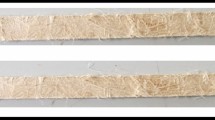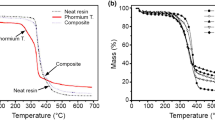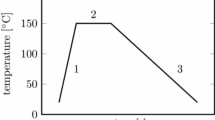Abstract
The mechanism for the temperature dependence of the tensile strength of unidirectional hybrid type Si-Ti-C-O (Tyranno) fiber-reinforced aluminum matrix composite, in which SiC-particles are dispersed in the matrix, is discussed, focusing on the temperature dependencies of the stress concentration arising from broken fibers and critical length and their influences on the composite strength, by means of a shear-lag analysis and a Monte Carlo simulation. The main results are summarized as follows. The softening of the matrix at high temperatures raises the composite strength from the point of decrease in stress concentration, but on the other hand, it also reduces strength from the point of increase in critical length, which reduces the stress-carrying capacity of broken fibers over a long distance. The reason why the measured strength of composite decreased with increasing temperature could be attributed to the predominacy of the latter effect over the former one. The results of the simulation indicated that the hybridization of the composites improved room-temperature and high-temperature strengths through the strengthening of the matrix.
Similar content being viewed by others
References
A. Sakamono:Bull. Jpn. Inst. Met., 1988, vol. 27, pp. 860–68.
J. Krestchmer:Mater. Sci. Technol, 1988, vol. 4, pp. 757–67.
T. Yamamura, T. Huruhashi, M. Kimoto, T. Ishikawa, M. Shibuya, and T. Iwai:High Tech. Ceramics (Proc. 6th Int. Meeting on Modern Ceramics Technologies, Milan, Italy, 1986), P. Vincenzini, ed., Elsevier Science Publishers, Amsterdam, 1987, pp. 737–46.
Y. Waku, T. Yamamoto, M. Suzuki, M. Tokuse, T. Nagasawa, and T. Nishi:34th Int. SAMPE Symp., 1989, vol. 34, pp. 2278–88.
Y. Imai, H. Ichikawa, and T. Ishikawa:Mechanical Properties and Application of MMC, Proc. Japan—France Workshop on MMC, Paris, S. Nishijima and C. Bathias, eds., The Science and Technology Agency, Tokyo, Japan, 1992, pp. 37–47.
S. Ochiai and K. Osamura:J. Mater. Sci., 1988, vol. 23, pp. 886–93.
C. Zweben:Eng. Frac. Mech., 1974, vol. 6, pp. 1–10.
S. Ochiai, K. Abe, and K. Osamura:Z. Metallkd., 1985, vol. 76, pp. 299–306.
S. Ochiai and K. Osamura:J. Mater. Sci., 1989, vol. 24, pp. 3865–72.
S. Ochiai, K. Osamura, and K. Abe:Z. Metallkd., 1985, vol. 76, pp. 402–08.
S. Ochiai and K. Osamura:Metall. Trans. A, 1990, vol. 21 A, pp. 971–77.
K. Matsunaga, S. Ochiai, K. Osamura, Y. Yaku, and T. Yamanura:J. Jpn. lnst. Light Met., 1993, vol. 43, pp. 219–24.
D. Masutti, J.P. Lentz, and F. Delannay:J. Mater. Sci. Lett., 1990, vol. 9, pp. 340–42.
ASM Metals Handbook, 9th ed., ASM INTERNATIONAL Metals Park, OH, 1979, vol. 2, pp. 62-122.
A. Kelly and W.R. Tyson:J. Mech. Phys. Sol., 1965, vol. 13, pp. 329–50.
W. Weibull:J. Appl. Mech., 1951, vol. 18, pp. 293–97.
Y. Matsuo: inEvaluation of Mechanical Property of Ceramics, T. Nishida and E. Yasuda, eds., Nikkan-kogyo, Tokyo, Japan, 1986, pp. 41-61 (in Japanese).
K. Matsunaga, S. Ochiai, K. Osamura, Y. Waku, and T. Yamamura:J. Jpn. lnst. Met., 1993, vol. 57, pp. 1035–40 (in Japanese).
I.H. Kahn:Metall. Trans. A, 1976, vol. 7A, pp. 1281–89.
A.G. Metcalfe and M.J. Klein:Interface in Metal Matrix Composites, Academic Press, New York, NY, 1974, pp. 125–68.
W.H. Hunt, Jr.:Interfaces in Metal-Matrix Composites, A.K. Dhingra and S.G. Fishman, eds., TMS, Warrendale, PA, 1986, pp. 3–25.
G. Simmons and H. Wang:Single Crystal Elastic Constants and Calculated Aggregate Properties, A Handbook, MIT Press, Cambridge, MA, 1971, p. 156.
Author information
Authors and Affiliations
Rights and permissions
About this article
Cite this article
Ochiai, S., Matsunaga, K., Waku, Y. et al. Temperature-dependence mechanism of tensile strength of Si-Ti-C-0 Fiber-Aluminum matrix composites. Metall Mater Trans A 26, 647–652 (1995). https://doi.org/10.1007/BF02663914
Received:
Issue Date:
DOI: https://doi.org/10.1007/BF02663914




